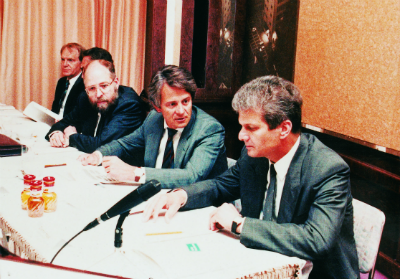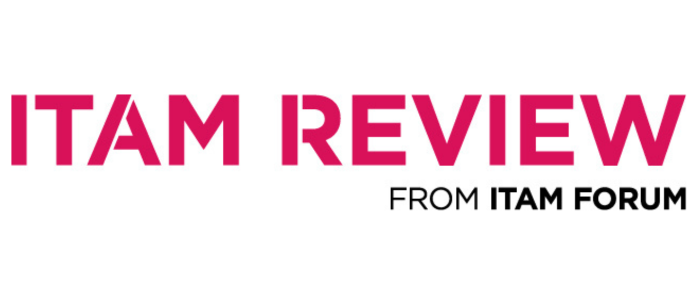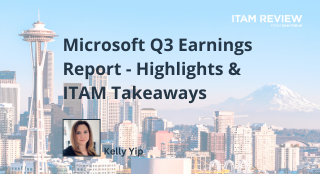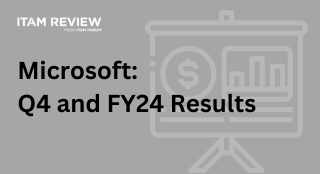Lifting the Lid on SAP Engines

SAP founders: Klaus Tschira, Hasso Plattner, Dietmar Hopp (from left to right) in 1982
This article has been contributed by Chris Hughes of Flexera Software.
SAP engines (also known as packages) are optional applications for which additional licenses must be purchased. The metric used for licensing is unique to each engine, and based upon the objects that exist within that application.
For example, SAP Payroll Processing uses the number of master records while SAP E-Recruiting uses the number of employees. Other metrics include the number of orders, contracts, patients, etc.
Many engines provide counting functions used by the SAP measurement program (USMM) to determine whether an engine is being used and how, and the results are included in the License Administration Workbench (LAW) report.
Each counting function returns one or more measurements which can subsequently be used to determine the total license consumption for an engine. For example, in one recent landscape we analysed, SAP Human Resources returned 15 measurements but only three of those contributed to the actual license consumption.
The reason why there can be more measurements than needed for the license calculation is that SAP doesn’t remove old measurements as the system evolves, at least in some cases, for compatibility between various versions of the SAP Basis and the engines. Rather, new measurements are simply added – and it’s up to customers to know which ones are important in which scenarios.
Not all engines are measured using a counting function. In any case, it may be unwise to measure license consumption only at true-up time. More regular measurements will better allow an organization to plan its SAP spend and avoid nasty surprises at true-up time. With the right techniques, you can lift the lid on engine license consumption anytime.
Let’s explore:
- Running counting functions:
Each SAP system stores a list of engines and counting functions in the TUAPP table. The counting functions can be run independently of the SAP measurement program at any time to gather the latest measurements.Once the measurements have been gathered, they must be combined in various ways, as defined by the license agreement, to determine the current license consumption for each engine. It is recommended that organizations work closely with an SAP licensing expert to avoid potential pitfalls which include:- Some counting functions may return measurements from the end of the last period (i.e. at true-up) and should not be used to calculate the current license consumption.
- Some engines are considered to be active only when their measurements exceed a threshold value – below this threshold the engine is considered inactive.
- Many measurements are not used in license calculations – in the SAP Human Resources example above, only 3 of 15 measurements were relevant.
- License calculations may change based on various conditions. For example, the license calculation for the SAP Human Resources engine varies based on both the Basis version and the price list version.
- Several measurements contain a program error and according to SAP are no longer considered relevant for licensing, but USMM will continue to return measurements as if everything is working properly.
- Some engine measurements are not reliable when certain other engines are also found in the same landscape.
- Your SAP contract may contain clauses that change how individual engines should be measured.
- Analysing CPU consumption data: Some engines are licensed based on the number of users using the application. The methods for accurately determining the number of users can be complex and must be performed for usage during the true-up period.
- Counting employees: There are many ways to measure the employees in your organization, for engines licensed by number of employees. Possibilities include counting the active personnel records in SAP Human Resources, user objects in Active Directory, user records in your configuration management system and much more.
 SAP offers hundreds of engines, and the variety of measurements makes engine licensing a very challenging problem. The techniques above can be applied to many SAP engines but there are many exceptions as well.
SAP offers hundreds of engines, and the variety of measurements makes engine licensing a very challenging problem. The techniques above can be applied to many SAP engines but there are many exceptions as well.
Support for engines in SAP license optimization solutions is limited; especially those products that run externally to SAP and so cannot access its engine counting functions. To be successful not only requires a product with engine capabilities but most importantly a vendor with the expertise to guide you safely through the pitfalls.
This article has been contributed by Chris Hughes of Flexera Software.
Can’t find what you’re looking for?
More from ITAM News & Analysis
-
How ISO/IEC 19770-1 Can Help Meet FFIEC Requirements
In the world of ITAM, the regulatory spotlight continues to intensify, especially for financial institutions facing increasing scrutiny from regulatory bodies due to the growing importance of IT in operational resilience, service delivery, and risk management. ... -
Microsoft Q3 Soars as AI and Azure Growth Fuels Market Gains
On the 30th April, Microsoft released its Q3 quarterly earnings report, exceeding expectations and igniting investor optimism. Investors had been keeping a watchful eye on Azure’s Cloud performance after Microsoft’s Q2 Cloud results fell short of ... -
AI and ITAM: State of Play 2024 Research Report
In 2024, the ITAM Forum and General Interfaces conducted a global survey (On behalf of the ITAM Forum’s AI+ITAM Working Group) targeting ITAM practitioners, executives, and stakeholders to explore the growing influence of AI on the ...
Podcast
ITAM training
Similar Posts
-
Microsoft Q3 Soars as AI and Azure Growth Fuels Market Gains
On the 30th April, Microsoft released its Q3 quarterly earnings report, exceeding expectations and igniting investor optimism. Investors had been keeping a watchful eye on Azure’s Cloud performance after Microsoft’s Q2 Cloud results fell short of ... -
The High Cost of Oracle Java: Managing Expenses and Operational Efficiency
For businesses reliant on Java, Oracle’s licensing model presents a formidable challenge. Once a freely available technology, Java has evolved into a costly necessity for enterprises, with licensing changes leading to widespread financial and operational concerns. ... -
Microsoft: June 2024 Q4 and FY24 Results
Microsoft Corp recently announced its June 2024 Q4 and FY24 end-of-year results. Looking at the overall results across all sectors, the total revenue for Microsoft increased by 16% to a total of $245.1 billion with a ... -
Adobe Sued by FTC for Unfair Selling Practices
The Federal Trade Commission has announced legal proceedings against Adobe and two of its senior executives for what it claims is misleading and complex terms and activities related to cancellation of software subscriptions. Section 8403 of ...




